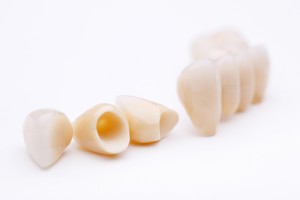Much as a bridge spans a gap between two geographical areas, dental bridges fill in the spaces created by one or more missing teeth. In most cases, a dental bridge is a permanent prosthetic device. This is in contrast with dentures, which are typically removed from the mouth while sleeping.
How Do Bridges Work?
A bridge is comprised of two or more crowns accompanied by a false tooth or teeth in between. The crowns are placed over your natural teeth (called the abutment teeth), which serve as anchors keeping the false tooth/teeth in position. The false teeth are referred to as pontics and are made of gold, alloys, porcelain, or some combination of these materials.
Your dentist, Dr. Matson, will help you decide which materials should make up your bridge, based on various factors including which teeth are missing, aesthetic value, and cost.
How Does the Process Work?
First, your dentist will slightly reduce the size of the abutment teeth so that the crown or bridge will fit over them properly. Next, he will take an impression of your mouth – this will serve as the mold for your new bridge. If your bridge will be made of porcelain, your dentist will select the shade that best matches your other teeth.
This impression will next be sent to a dental lab where a technician will manufacture a bridge according to the mold’s specifications using the material specified by your dentist. You will typically receive a temporary crown or bridge to cover the prepared tooth/teeth until the permanent bridge is ready. Once it is complete, your dentist will remove the temporary device and fix the new bridge over your prepared teeth using a special form of cement.
How Long Should It Last?
Dental bridges usually last anywhere from 5 to 15 years – and even longer.
However, dental disease will drastically shorten the life of your bridge. This is because dental disease affects the abutment teeth, or even the bone holding those teeth in place. The key to avoiding dental disease is to maintain good oral hygiene, which includes brushing and flossing at least twice a day, and receiving regular check-ups and examinations with your dentist.
To prevent unnecessary damage to your bridge, avoid chewing on ice, hard candy, or other potentially damaging foods.
Following this routine will extend the life of your natural teeth – and any bridge you have installed, as well.

